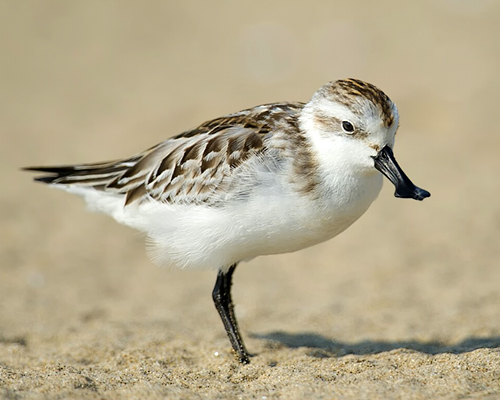
Birds Korea is a legally-registered Korean NGO, working for the conservation of birds and their habitats in Korea and the wider Yellow Sea Eco-region. We conduct scientific research, develop plans and designs and we conduct education and awareness-raising programs. Examples of our work can be found on our websites (with parallel websites in both Korean and English) and in our publications.
Much of our work remains focused on the conservation of Korea’s most threatened major habitat type: tidal-flats. Tidal-flats are vital to people and birds alike. Yet, 75% of our nation’s tidal-flats have already been reclaimed, with half of this area destroyed in only the past 25 years. As a result, fishing communities are in decline, and many of the bird species that depend on our nation’s tidal-flats are also in decline and even globally-threatened with extinction. These include the Critically Endangered Spoon-billed Sandpiper, a small migratory shorebird species with a total population of probably fewer than 300 individuals. Due to its high rate of decline (recently estimated at 25% of the population every year), the Spoon-billed Sandpiper is now predicted to become globally extinct in the wild within this decade, unless much greater conservation actions are taken. The Spoon-billed Sandpiper therefore might soon become the very first Korean bird species to go extinct within the present century. Its extinction, terrible in itself, would signal the loss and degradation of the nation’s most important tidal-flats – and the decline and disappearance of many other less well-known tidal-flat species.
The extinction of the Spoon-billed Sandpiper is far from inevitable, however. More and more people are now working to conserve the species, here in the Republic of Korea (ROK) and overseas. All understand that if many of us – individuals, NGOs, academics, media and governments - work together for conservation, then the Spoon-billed Sandpiper and many other tidal-flat species will be saved from extinction. Success will depend largely on improved scientific knowledge and on much greater public awareness. Birds Korea therefore became the Korean NGO member of the International Spoon-billed Sandpiper Recovery Task Force in 2006; has conducted research on the species every year since then; and in 2012 decided to try to make our own mini-documentary on the species, with the aim of completion by mid-2014.
As planned, this mini-documentary will help make clear the connection between reclamation and extinction. It will also introduce best examples of conservation work for the Spoon-billed Sandpiper. Presented entirely in Korean (though perhaps with English subtitles), we believe that this documentary will be of great interest to a wide audience – especially as our nation prepares to host the next Conference of the Parties of the Convention on Biological Diversity (in October 2014).
Already, we have been able to gather some great footage by ourselves. However, we need and welcome the support and expert input of others. In addition to discussing the project with an award-winning documentary maker in Busan, we therefore contacted the world-famous Cornell Lab of Ornithology in the United States. The multimedia department within the Cornell Lab has already captured the best footage of Spoon-billed Sandpipers ever taken in its remote Russian breeding grounds; and has filmed the species in its winter home in Burma. They have been active supporters of the Spoon-billed Sandpiper Task Force for several years; and their expertise and experience are vital to any top-quality documentary on this species.
Our collaboration is still in its earliest stages and much remains to be done. Nonetheless, in early 2013, Birds Korea and the Cornell Lab agreed to work together to gather footage of the Spoon-billed Sandpiper and the threats to it in the ROK. At the invitation of Birds Korea, a small (elite!) team from the Cornell Lab will therefore come to the ROK, between October 2nd and October 12th 2013. Weather and tides (and birds!) allowing, we aim together to capture images and footage of Spoon-billed Sandpipers at the internationally important Nakdong Estuary, Geum Estuary and Gomso Bay; we will record landscapes of rich tidal-flats and areas that have been devastated by reclamation, as at Saemangeum; we will document human communities still dependent upon the tidal-flats; and we will conduct further interviews with people vital to successful conservation.
Simply taking good footage will not be enough – either for the mini-documentary project or for the Spoon-billed Sandpiper and the tidal-flats it depends on. There is much work ahead. Birds Korea has limited capacity and a massive workload. Always, our organisation and the success of our work both depend entirely on our members and supporters – on you.
To learn more about how you can support this mini-documentary project and our other work, please visit our websites and / or contact us.
We welcome and are most grateful for your support.
Thank you!
Nakdong Estuary, October 3rd
Birds Korea has for some time now been gathering material for a mini-documentary aiming to tell the story of the Spoon-billed Sandpiper in Korea. This work led to discussions with the world-renowned Cornell Lab of Ornithology (CLO), which is also deeply invested in raising awareness about this superbly iconic and Critically Endangered species. The CLO have already taken some breath-taking footage of Spoon-billed Sandpipers at the nest in Chukotka (if you have not yet seen it – please treat yourself!) but they have yet to get good footage of “Spoonies” in the Yellow Sea. So at the invitation of Birds Korea, the CLO’s Mr. Gerrit Vyn and Mr. Adam Sedgley arrived in the ROK late on October 2nd – to film Spoon-billed Sandpipers and Korean wetlands – before then heading on to Rudong, and more Spoonies in China, on October 12th.
Leaving Incheon behind (where ironically two Spoon-billed Sandpipers the Nakdong Estuary where two were well-watched last week. With the tide out and shorebirds dispersed, only one Spoon-billed Sandpiper was seen during the day – unfortunately too distant for any camera. The total number of shorebirds was also much lower than a week ago, with probably only 500 Red-necked Stint and 100-150 Sanderling (many beautifully confiding, however). Nonetheless, numbers of some species were rather higher, with e.g. single Black-winged Stilt and Common Redshank, 70+ Great Knot, perhaps 30 Far Eastern Curlew, c.100 Kentish Plover, 40 Mongolian Plover and 3-4 Greater Sand Plover. Two of the Kentish Plover-types will be worth looking for again tomorrow – one was very rusty-toned and had clean white lores; the other was strikingly hefty and massive-billed.
In addition to a few hundred duck and one Bean Goose sensu lato, further species of interest during the day included a Dusky Warbler (in Namcheon Dong), single Red-throated Pipit, and two Richard’s and Buff-bellied Pipits.
What will tomorrow bring?
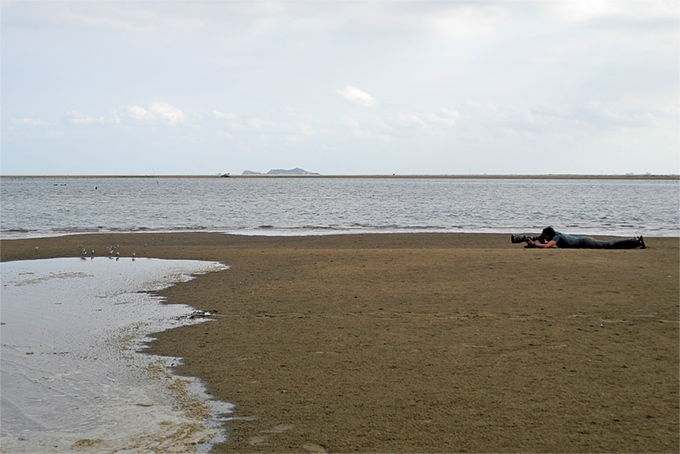
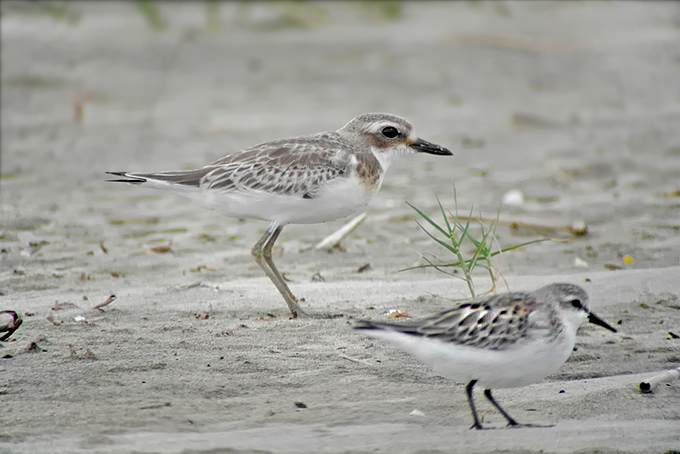
Nakdong Estuary, October 4th
Back out to the Nakdong Estuary under almost clear skies with a brisk northerly wind, whipping up waves and sand. With high tide at 8AM a 6AM start ensured excellent looks at roosting shorebirds – with probably 1300+ Red-necked Stint still, with next most numerous Sanderling (200), Kentish Plover (150), Mongolian Plover (90-100) and Far Eastern Curlew (60+)…However, as on the 3rd, only the briefest view of a juvenile Spoon-billed Sandpiper was enjoyed (and that by NM only). On Doyodung Island in the outer part of the estuary, other species of note included a stunning juvenile Sharp-tailed Sandpiper, a good mix of pipits, with 8+ Pechora and 10+ Richard’s Pipits the most numerous, and a single Short-toed Lark (presumably Greater) heard briefly. In addition to watching GV crawl on his belly to within 1-2m of a flock of unconcerned stints, a further highlight was provided by the arrival of Mr. Chin Jae-Un (award-winning documentary-maker and TV news reporter) with a crew from KNN. Today’s interviews and some CLO footage of Spoon-billed Sandpipers on the breeding grounds was apparently already broadcast tonight – with recognisable Spoonies on domestic TV likely a national first. After a long lunchtime discussion, the late afternoon was spent filming landscapes at Miyeonji – where several hundred duck were present along with 20+ Taiga Bean and two Swan Goose. Final highlight of the day was a Eurasian River Otter, swimming and walking only metres away from hordes of people passing by on the tracks above the sea-wall. How many people in Busan know how special this estuary is? How many people anywhere know about the wildlife around them?

Gwangju (am); Geum Estuary (pm), October 5th
Thanks to the generosity and hard work of Prof. Seong Ha-Cheol and his students and of course of the tireless Prof. Maria Lisak, a morning seminar on “The Spoon-billed Sandpiper: Korea’s Most Endangered Bird Species” was held at Chonnam National University, Gwangju in the morning. Although time for preparation was extremely limited (our apologies for that!), about 40 people attended to listen to presentations on shorebird research at Chonnam University (Prof. Seong); on the Korean Shorebird Network (Mr. Andreas Kim on behlaf of Mr.Lee Kyung-Gyu, the Network’s Secretary); on Birds Korea and the Spoon-billed Sandpiper (by Ms. Park Meena and Dr. Nial Moores); and on the CLO’s work for the Spoon-billed Sandpiper (Mr. Gerrit Vyn, CLO), sharing some stunning footage of Spoonies on the nest in Chukotka. Questions asked of the presenters were all focused on the Saemangeum reclamation and its huge negative impacts on shorebirds and human communities – and included a passionate plea by Prof. Park Si-Young to all participants to tell everybody that the Saemangeum tidal-flats are not dead and that much of the wetland can be restored.
The afternoon was spent by several Birds Koreans (Mr. Jason Loghry, Mr. Ha Jung-Mun and Dr. Nial Moores, accompanied by Ms. Lee Gi-Sun – one of the finders earlier in the week of the Song Do Spoon-billed Sandpiper) and the CLO team. And yes, we found, photographed and filmed Spoonies! With birds moving around numbers are unclear, though probably 10 or more Spoon-billed Sandpiper were found in total that afternoon. Also present were two Nordmann’s Greenshank and at least half-a-dozen Chinese Egret.
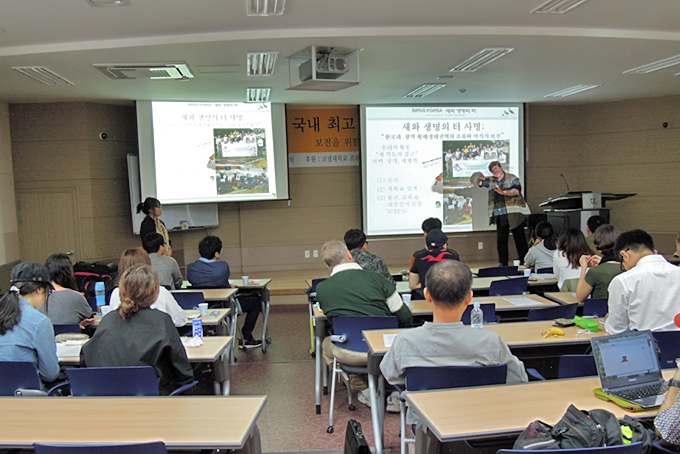
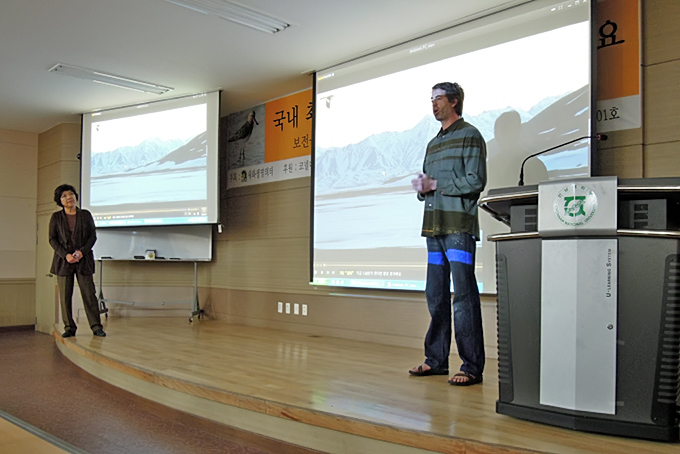
Geum Estuary & Saemangeum, October 6th
Under overcast skies with occasional rain showers, the main team visited the Geum Estuary – capturing some excellent footage of a Spoon-billed Sandpiper coming in at high tide: superb. Dr. Moores revisited the northern part of Saemangeum in the afternoon instead. To the backdrop of dumper trucks and other heavy machinery busy dropping rocks into the tidal-flat, a small area of tidal-flat (with a tidal-range of only a few cms) held 1850+ Red-necked Stint and a few hundred other shorebirds, including 195 Kentish Plover, 35 Dunlin and 10 Common Redshank. With high tide outside of Saemangeum, 963 Far Eastern Curlew were counted coming in from the Geum, most carrying on to a narrow strip of tidal-flat near the airport (where 150 Black-tailed Godwit were already present). Also present in the same area of Saemangeum were three Black-faced Spoonbill, at least one juvenile Little Stint, and best of all four Spoon-billed Sandpiper (with three of these magical birds watched feeding together)! What will tomorrow bring?



